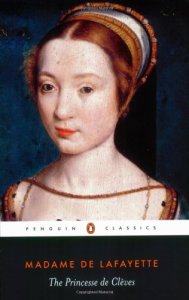I read three (very short) novels by Madame de Lafayette while in Europe, or rather, three novels suspected to have been written by her, since a woman dared not put her name on a work. They were: Princess de Clèves, The Princess de Montpensier, and The Comtesse de Tende. All were illuminating about court life to a point. The complete absence of children was curious. Overall, I was annoyed with the obsessive romantic interest, it reminded me of Grade Nine. The intense need to conceal emotions as well as the intensity of these “affairs of the heart,” these “involuntary passions,” was interesting, however.
“… there reigned at court a kind of orderly unrest which made life very enjoyable, but also very dangerous for a young girl.”
– The Princess de Clèves
Did love exist within a noble marriage? There seemed to be some contradiction on this point. A mother arranges a marriage for her daughter, believing that she is giving her a husband she could love. Passionate romantic love is assumed to be the province of an extramarital affair, yet sometimes a husband truly loves his wife. (Curiously, the reverse is not the case in any of these stories.)
These are historical novels, and often the known historical record was altered to suit the fiction: time shortened or lengthened, characters changed.
I would not call these works “novels” personally, there were few scenes, and very little dialogue. Rather, they seemed a told account, in the manner of a fable. I was surprised to read in the introduction that The Princess de Clèves is considered the first novel written in Europe. It was published in France in 1678. This must be a very narrow definition of what constitutes a “novel,” for the comic novel Don Quixote (Part 1) was published in 1605.
This, from Wikipedia:
La Princesse de Clèves proved that France could actually produce novels of a particularly French taste. The Spanish enjoyed stories of proud Spaniards who fought duels to avenge their reputations. The French had a more refined taste with minute observation of human motives and behavior. The story was firmly a “novel” and not a “romance”: a story of unparalleled female virtue, with a heroine who had had the chance to risk an illicit amour and not only withstood the temptation but made herself more unhappy by confessing her feelings to her husband. The gloom her story created was entirely new and sensational.
As an aside, it is said to be possible that The Princess de Clèves was possibly written by Ségrais (a man) or was a group project. My feeling is that the parts of the novel that concern emotions are very much the same voice of the other two novels, that of Madame de Lafayette, in short. Now and then there is a chunk of text inserted that is entirely not in keeping with that voice: long, factual, historical accounts. For these, I suspect a man’s hand.




Another Princesse of Cleves fan! Hooray! Have you had a chance to look at the 1668 debates about whether or not the Princess should have admitted her love for Nemours? Quite a scandal at the time!
Holly
http://www.wondersandmarvels.com